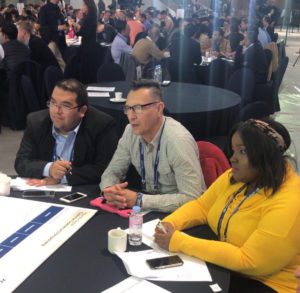Last year, sales and service representatives from across Hyundai Motor dealerships had the opportunity to participate in a series of competitions to prove they knew more about each car and how to sell it than any of their peers. Over several months, thousands of reps from this $83 billion global automotive company competed in a series of “workarounds,” in which they presented a vehicle to a “customer,” explaining every feature and function starting with the hood and working back to the exhaust pipe.
“We don’t just judge them on what they know but how they link the value of those features to a customer’s daily life,” said Jared Dowdy, senior manager of national sales training for Hyundai Motor America. The competitions laddered up from local, to regional, to national competitions with prize money awarded at each stage. Ultimately, the top two winners from each country — 136 reps in all — were invited to Hyundai headquarters in Seoul, South Korea, for a final global customer experience competition — the Hyundai Global CX Championship.
Raw Emotion Beats Boring Text
The automotive industry has a long history of using workarounds to identify its highest performers. It’s a way to celebrate their sales strategy and reward them with recognition and cash prizes. This year’s national winners each took home $10,000.

However, Hyundai sees these competitions as more than just a chance to glorify its best sales reps. They provide the company with a compelling learning opportunity that you just can’t get in a classroom, Dowdy said. Every year all of the sales reps need to be trained on every unique feature in a new lineup of cars, and those features can quickly blur together. “At some point, it just becomes white noise,” he said. “But seeing their peers talk about the features differently than they would, and the raw emotion and passion they show for the product, can be an amazing learning experience.” Instead of rattling off a list of facts, they see how the best reps engage with customers and get them excited about how this car will change their lives.
In 2018, Hyundai took this learning opportunity one step further by integrating virtual reality, artificial intelligence and custom apps into the global round, as well as adding a service competition to the program. “Sales and service are usually siloed in the automotive industry,” said Vlad Shishkaryov, CEO of Bridge Learning Technologies, the management consultancy that created the technology for the competition. Lack of communication between the two teams can cause customer service to suffer. “Integrating sales and service into the same competition and having them involved at the same time in some rounds is helping to break down those silos,” Shishkaryov said.
Traditionally, competitors in the final competition would complete a series of written tests, then participate in role-playing scenarios that were judged by company leaders. This format presented some obvious challenges, explained Judy Carney, Bridge LT’s project manager. With competitors coming from all over the world, language translation created a potential for bias in judging. Even when live role-playing scenarios were eventually translated, they often lost the passion, detail and cultural elements that shaped the real-life presentation, forcing judges to assess a written version rather than the live event. It also made it harder to share those presentations as learning tools.
Leveling the Playing Field
With Bridge LT’s help, Hyundai reformatted the competition to reflect real-life scenarios that sales and service reps would encounter, then used AI and apps to “level the playing field,” Carney said. In the first round, which was completed prior to arriving in Seoul, competitors used the app to create video responses to 25 structured interview questions about the new vehicle models and various sales scenarios. They had no information about the questions prior to opening the app and had just a few minutes to read each question and complete their responses.
The submissions were then uploaded, translated, transcribed and delivered to the judges to be assessed. The app is capable of translating responses in 20 different languages. “The translations meant every judge could review every competitor’s responses, and the best practices they captured could be shared with dealerships worldwide,” Shishkaryov said.
A Very Stern English Lady
The next two rounds of the final competition took place at Hyundai Motor studio in Seoul. “It was like the Oscars for the car industry,” said Jason Hearn, a sales rep from South Carolina who made it to the finals. “We all felt very important.”
Before entering the studio, the reps all had to surrender their phones and cameras to protect the secrecy of the event, which included a detailed model of a 2020 Hyundai. The competitors were then split into groups of sales and service reps where they were quizzed on the history of the brand and features in the vehicles, and discussed appropriate responses to different scenarios.
The final round involved role-plays — the highest stress element of the contest. Each competitor was brought into a room with a vehicle and an actor acting out a predefined sales or service scenario. The competitors, who had no idea what was going to happen, had to respond on-the-fly as judges observed. “There were cameras everywhere,” said Hearn. “It was like the paparazzi were watching us.”
All role-plays were uploaded to a server, which delivered instant translations that were made available for the judges to review in real time. “It didn’t matter where the judges were from, everyone could judge everyone,” Shishkaryov said. “It created a lot more transparency.”
Using technology to capture the events transforms the competition into a learning opportunity for the whole company, Carney said. “Instead of just handing out awards and going home, we are able to put the experiences into a usable format that can be embedded into Hyundai’s learning process.”
In Hearn’s scenario, he was told that a sales rep called in sick and he had to complete handover of a new car to an irate customer played by Carney, who Hearn described as “a very stern English lady.” “I was trying to push people into uncomfortable situations to test how they would perform,” Carney laughed. “So I said, ‘This is ridiculous!’ a lot.”
In the scenario her new car hadn’t yet been washed, her second key was missing, and Carney was already late to an appointment. As Carney berated him, Hearn used tools he learned in his previous life as a corrections officer to empathize with her situation and meet her needs. Using soothing tones, he reassured her that the car would be ready soon, offered her a loaner to attend her appointment, and said he’d wash the car himself. “She was still stern, but I solved the problem,” Hearn said.
In the second scenario, he had to demonstrate the features on a new Hyundai electric car to a VIP guest, even though he’d never seen the car before and knew nothing about it. He noted that some competitors in this round gave up in frustration, but he was willing to wing it using what he knew about past hybrid models and identifying features as he spotted them. “These kinds of situations happen in real life,” he said. “You just have to go with it.”
More Than a Competition
These are the kinds of best practices Dowdy is excited to show to the rest of his salespeople. “Being able to capture these moments and share them online is powerful,” he said. “Watching these role-plays will be a lot more impactful for them than reading about the features in a workbook.”
Dowdy’s team is now in the process of curating the best videos from the app and the role-plays to share via the company’s online learning library. He believes this kind of real-life raw content is a valuable addition to the 21 full-time trainers who work with reps at 636 dealerships around the country. “They don’t have time to be everywhere,” he said. He also plans to use the app as a learning platform where reps can submit questions about sales scenarios or new products and get instant feedback from the coaches.
“It’s all part of Hyundai’s commitment to continuous improvement,” Shishkaryov said. The sales reps are motivated to learn about the products and new sales strategies so they can compete in the workarounds, then their best practices can be shared with the rest of the company to foster a culture of continuous learning. “The sales reps love the opportunity to showcase what they do, and this gives them another incentive to create learning content that others can benefit from.”
Dowdy said this example is a lesson that with the right technology and a little inspiration, learning leaders can find opportunities to capture best practices throughout the company — in coaching sessions, competitions and sales events.
The key, added Shishkaryov, is to look for ways that technology can help companies create a more dynamic and inspiring learning experience. “The possibilities in this field are only limited by our imagination.”














